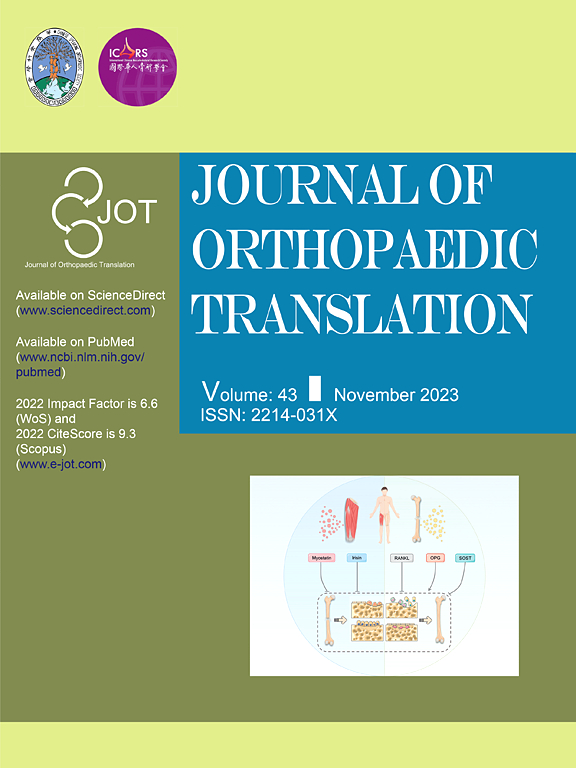哑铃形水凝胶塞用于纤维环修复:从材料设计到体内验证
IF 5.9
1区 医学
Q1 ORTHOPEDICS
引用次数: 0
摘要
背景:椎间盘(IVD)突出是一种退行性脊柱疾病,目前的治疗经常由于医源性纤维环(AF)缺陷而导致再次突出。制定有效的房颤修复策略对于预防再疝和改善手术效果至关重要。本研究旨在开发一种新型的水凝胶塞来修复严重的房颤缺损,提高手术效果并降低再疝的风险。方法以哑铃为灵感,采用甲基丙烯酸酯接枝透明质酸和四臂聚乙二醇制备新型水凝胶塞。通过IVD有限元(FE)模型优化了桥塞的几何形状,调整了球根端的厚度、半径和曲率。扫描电子显微镜表征了水凝胶的微观结构。通过冷冻干燥和复水化测试来评估膨胀行为,通过压缩和拉伸测试来评估力学性能。在体外和体内进行了降解研究。通过细胞毒性试验和小鼠皮下植入对材料的生物相容性进行了评价。采用腰椎有限元模型分析哑铃形堵头的修复效果,并通过动态力学试验验证其修复效果。最后,将桥塞插入山羊IVD损伤模型,比较未损伤、未修复和缝合修复情况下与山羊模型的修复效果。采集的样本通过MRI和组织学分析进行评估,并通过力学测试验证修复的稳定性。结果制备的水凝胶溶胀迅速,力学性能与天然AF相似,降解稳定,具有良好的生物相容性。对于3 mm的缺损,有限元模拟结果表明,内球根端半径为2.25 mm,厚度为1.5 mm,曲率为20-30°的塞可以提供最均匀的应力分布和最佳的腰椎稳定性。该栓成功植入离体腰椎模型,并在10,000次循环载荷后保持其位置。在山羊体内模型中,4周后MRI未观察到明显的栓变性。组织学和免疫染色结果显示,塞组和缝合组均无明显炎症,有轻微的血管和纤维组织形成。与缝合修复组和未治疗组相比,塞组表现出更好的抗压强度。结论本研究开发并测试了一种用于修复AF大缺损的新型水凝胶塞系统。与传统缝合相比,水凝胶塞修复AF具有优越的机械性能、更好的生物相容性和更有效的缺陷修复。鉴于目前缺乏修复AF重大缺陷的产品,本研究开发了一种具有优异机械性能和生物相容性的新型水凝胶塞系统,从而实现了AF的有效修复。该植入物在微创脊柱手术中具有巨大的临床转化潜力,可用于治疗严重的房颤缺陷。本文章由计算机程序翻译,如有差异,请以英文原文为准。

Dumbbell-shaped hydrogel plug for annulus fibrosus repair: From material design to in vivo validation
Background
Intervertebral disc (IVD) herniation is a degenerative spine disease, and current treatments often result in reherniation due to iatrogenic annulus fibrosus (AF) defects. Developing effective AF repair strategies is critical to preventing reherniation and improving surgical outcomes. This study aims to develop a novel hydrogel plug to repair significant AF defects, improving surgical outcomes and reducing the risk of reherniation.
Methods
Inspired by Dumbbell, a novel hydrogel plug was developed using methacrylate-grafted hyaluronic acid and 4-arm polyethylene glycol. The plug's geometry was optimized via an IVD finite element (FE) model, adjusting the bulbous end's thickness, radius, and curvature. A scanning electron microscope characterized the hydrogel's microstructure. Swelling behavior was assessed through freeze-drying and rehydration, and the mechanical properties were evaluated by compression and tensile testing. Degradation studies were performed in vitro and in vivo. The material's biocompatibility was assessed with cytotoxicity assays and subcutaneous implantation in mice. The repair efficacy of the dumbbell-shaped plug was analyzed using the lumbar spine FE model and was validated through dynamic mechanical testing. Finally, the plugs were inserted into the goat IVD injury model to compare the repair effects with the goat model for non-damaged, non-repaired, and suture-repaired conditions. The harvested samples were assessed using MRI and histological analysis, and the stability of the repair was verified through mechanical testing.
Results
The hydrogel exhibited rapid swelling, had mechanical properties similar to the natural AF, showed a stable degradation profile, and had excellent biocompatibility. For repairing a 3 mm defect, the FE simulation showed that a plug with an inner bulbous end radius of 2.25 mm, a thickness of 1.5 mm, and a curvature of 20–30° provided the most uniform stress distribution and optimal lumbar stability. The plug was successfully implanted into an ex vivo lumbar model and maintained its position after 10,000 cyclic loads. In the vivo goat model, no marked degeneration of the plug is observed on MRI after 4 weeks. Histological and immunostaining results revealed no significant inflammation, with slight vascular and fibrous tissue formation in both the plug and suture groups. The plug group demonstrated superior compressive strength compared to the suture repair and the untreated group.
Conclusion
This study developed and tested a novel hydrogel plug system for repairing large AF defects. The hydrogel plug resulted in an AF repair with superior mechanical properties, better biocompatibility, and a more effective defect repair than traditional suturing.
The translational potential of this article
Given the current lack of products for repairing significant AF defects, this study developed a novel hydrogel plug system with excellent mechanical properties and biocompatibility, resulting in an effective AF repair. This implant has substantial translational potential for clinical applications in minimally invasive spinal surgeries to address significant AF defects.
求助全文
通过发布文献求助,成功后即可免费获取论文全文。
去求助
来源期刊

Journal of Orthopaedic Translation
Medicine-Orthopedics and Sports Medicine
CiteScore
11.80
自引率
13.60%
发文量
91
审稿时长
29 days
期刊介绍:
The Journal of Orthopaedic Translation (JOT) is the official peer-reviewed, open access journal of the Chinese Speaking Orthopaedic Society (CSOS) and the International Chinese Musculoskeletal Research Society (ICMRS). It is published quarterly, in January, April, July and October, by Elsevier.
 求助内容:
求助内容: 应助结果提醒方式:
应助结果提醒方式:


